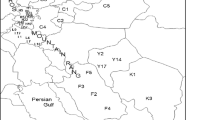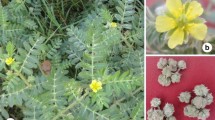Abstract
Amygdalus mira (Koehne) Ricker, originated in China, is a wild fruit tree distributed in Tibet with high economic and ecological value. To conserve its future breeding and germplasm resources, much information about genetic diversity of A. mira should be obtained. In this study, two DNA-based molecular markers, simple sequence repeat (SSR) and inter-simple sequence repeat (ISSR), were used for genetic diversity evaluations of 46 samples from four regions including Bomi (BM), Langkazi (LKZ), Mainling (ML) and Linzhi (LZ) in Tibet. Through combined analysis of SSR and ISSR, high levels of polymorphism (75.42 %) were observed, indicating that SSR and ISSR were efficient methods to detect genetic diversity of natural A. mira populations; all the samples were divided into two major clusters at the similarity coefficient of 0.54; the highest H and I values were observed in LZ population; most genetic variations occurred within populations; there is no significant relationship between genetic distance of populations and geographic distribution. For conversation of A. mira, ex situ conversation is a desired strategy needed to be established in the future.




Similar content being viewed by others
Abbreviations
- SSR:
-
Simple sequence repeat
- ISSR:
-
Inter simple sequence repeat
- RAPD:
-
Random amplified polymorphic DNA
- AFLP:
-
Amplified fragment length polymorphism
- CTAB:
-
Hexadecyl trimethyl ammonium bromide
- EDTA:
-
Ethylenediamine tetraacetic acid
- PCR:
-
Polymerase chain reaction
References
Aranzana MJ, Pineda A, Cosson P et al (2003) A set of simple-sequence repeat (SSR) markers covering the Prunus genome. Theor Appl Genet 106:819–825
Arnau G, Lallemand J, Bourgoin M (2003) Fast and reliable strawberry cultivar identification using inter simple sequence repeat (ISSR) amplification. Euphytica 129:69–79
Cantini C, Iezzoni AF, Lamboy WF et al (2001) DNA fingerprinting of tetraploid cherry germplasm using simple sequence repeats. J Amer Soc Hort Sci 126:205–209
Chaparoo JX, Werner DJ, O’Malley D et al (1994) Targeted mapping and linkage analysis of morphological, isozyme and RAPD markers in peach. Theor Appl Genet 87:805–815
Christensen S, von Bothmer R, Poulsen G et al (2011) AFLP analysis of genetic diversity in leafy kale (Brassica oleracea L. convar. acephala (DC.) Alef. landraces, cultivars and wild populations in Europe. Genet Resour Crop Evol 58:657–666
Dirlewanger E, Duha S, Viruel MA et al (1998) Identification of peach varieties using molecular markers. Acta Hort 465:69–78
Dong GZ (1991) The investigation of Prunus mira Koehne in Tibet. Quart For by-product Spec China 3:44–45
Doyle JJ, Doyle JL (1990) A rapid DNA isolation procedure for small quantities of fresh leaf tissue. Phytochem Bull 19:11–15
Dwivedi SL, Gurtu S, Chandra S et al (2001) Assessment of genetic diversity among selected groundnut germplasm. I: RAPD analysis. Pl Breed 120(4):345–349
Eriksson G, Namkoong G, Roberds JH (1993) Dynamic gene conservation for uncertain futures. Forest Ecol Manag 62:15–37
Excoffier L, Smouse PE, Quattro JM (1992) Analysis of molecular variance inferred from metric distances among DNA haplotypes: application to human mitochondrial DNA restriction data. Genetics 131:479–491
Fang JP, Zhong ZC, Zhong GH (2008) The age structure of Tibetan Prunus mira Koehne Kov et Kpsl population in Tibet Linzhi region. China For Sci Technol 22:53–56
Fu LK (2002) China plant red data book: rare and endangered plants. I. Science Press, Beijing
Gajera BB, Kumar N, Singh AS et al (2010) Assessment of genetic diversity in castor (Ricinus communis L.) using RAPD and ISSR markers. Industrial Crops Prod 32:491–498
Gole TW, Borsch T, Denich M et al (2008) Floristic composition and environmental factors characterizing coffee forests in southwest Ethiopia. Forest Ecol Manag 255:2138–2150
Goulao L, Oliveira CM (2001) Molecular characterisation of cultivars of apple (Malus 9 domestica Borkh.) using microsatellite (SSR and ISSR) markers. Euphytica 122:81–89
Hamilton MB (1994) Ex situ conservation of wild plant species: time to reassess the genetic assumptions and implications of seed banks. Conserv Biol 8:39–49
Hao HP, Jiang CD, Shi L et al (2009) Effects of root temperature on thermostability of photosynthetic apparatus in Prunus miraseeding. Chin J Pl Ecol 33:984–992
Hokanson SC, Szewc-McFadden AK, Lamboy WF et al (1998) Microsatellite (SSR) markers reveal genetic identities, genetic diversity and relationships in a Malus domestica Borkh. core subset collection. Theor Appl Genet 97:671–683
Hu D, Zhang A, Zhang D et al (2005) Genetic relationship of ornamental peach determined using AFLP markers. HortScience 40:1782–1786
Hu D, Zhang Z, Zhang Q et al (2006) Ornamental peach and its genetic relationships revealed by inter-simple sequence repeat ISSR fingerprints. Acta Hort 713:113–120
Huang HW, Cheng ZP, Zhang ZH et al (2008) History of cultivation and trends in China. In: Layne DR (ed) The peach: botany, production and uses (chapter 2). CABI, Wallingford, Oxfordshire, UK
Islam A (2004) Genetic diversity of the genus Curcuma in Bangladesh and further biotechnological approaches for in vitro regeneration and long-term conservation of C. longa germplasm. PhD thesis, University of Hannover
Kar PK, Srivastava PP, Awasthi AK et al (2008) Genetic variability and association of ISSR markers with some biochemical traits in mulberry (Morus spp.) genetic resources available in India. Tree Genet Genomes 4:75–83
Li T, Liu J, Xie Y, Wang Q et al (2014) Analysis of genetic diversity in Prunus mira Koehne ex Sargent populations using AFLP markers. Pl Syst Evol 300:475–482
Nei M (1973) Analysis of gene diversity in subdivided populations. Proc Natl Acad Sci USA 70:3321–3323
Powell W, Morgante M, Andre C et al (1996) The comparison of RFLP, RAPD, AFLP and SSR (microsatellite) markers for germplasm analysis. Molec Breed 2:225–238
Rahman MH, Jaquish B, Khasa PD (2000) Optimization of PCR protocol in microsatellite analysis with silver and SYBR stains. Pl Molec Biol Rep 18:339–348
Singh AK, Smartt J, Simpson CE et al (1998) Genetic variation vis-à-vis molecular polymorphism in groundnut, Arachis hypogaea L. Genet Resour Crop Evol 45:119–126
Smith JSC, Chin ECL, Shu H et al (1997) An evaluation of the utility of SSR loci as molecular markers in maize (Zea mays L.): comparison of data fro RFLPs and pedigree. Theor Appl Genet 95:163–173
Sneath PHA, Sokal RR (1973) Numerical taxonomy. Freeman, San Francisco, p 573
Sun SX, Li J, Chen D et al (2011) Molecular identification of peach germplasm by ISSR markers. Chin Agric Sci Bull 4:173–177
Tan JP, Zeng XI, Liao MA (2012) Genetic diversity of natural Prunus mira populations detected by SRAP. Acta Prataculturae Sin 21:213–220
Wang ZH, Zhuang EJ (eds) (2001) Fruit annals in China-Scroll of peach and nectarine. China Forestry Publishing House, Beijing (in Chinese)
Wunsch A, Hormaza JI (2004) Cloning and characterization of genomic DNA sequences of four self-incompatibility alleles in sweet cherry (Prunus avium L). Theor Appl Genet 108:299–305
Zeitkiewicz E, Rafalski A, Labuda D (1994) Genome finger printing by simple sequence repeat (SSR)-anchored PCR amplification. Genomics 20:176–183
Zhong ZC (2008) Studies on resource ecology of Prunus mira Koehne (Amygdalus mira Koehne kow et. Kpst) in Xizang (Tibet) Linzhi. Thesis for a MD degree in agricultural science from Agricultural and Animal Husbandry of Tibet University, China
Zhu HT, Li SD, Zhang P et al (2008) The initial study on physiological mechanism of dwarf on peach. J Shandong Forest Sci Technol 6:94–96
Acknowledgments
This study was supported by the Fundamental Research Funds for the Central Universities (No. DL13EA08-02), the National Natural Science Foundation of China (31170568; 31201594).
Author information
Authors and Affiliations
Corresponding author
Additional information
Handling editor: Frank H. Helwig.
Electronic supplementary material
Below is the link to the electronic supplementary material.
Rights and permissions
About this article
Cite this article
Xing, C., Tian, Y., Guan, F. et al. Evaluation of genetic diversity in Amygdalus mira (Koehne) Ricker using SSR and ISSR markers. Plant Syst Evol 301, 1055–1064 (2015). https://doi.org/10.1007/s00606-014-1136-3
Received:
Accepted:
Published:
Issue Date:
DOI: https://doi.org/10.1007/s00606-014-1136-3




